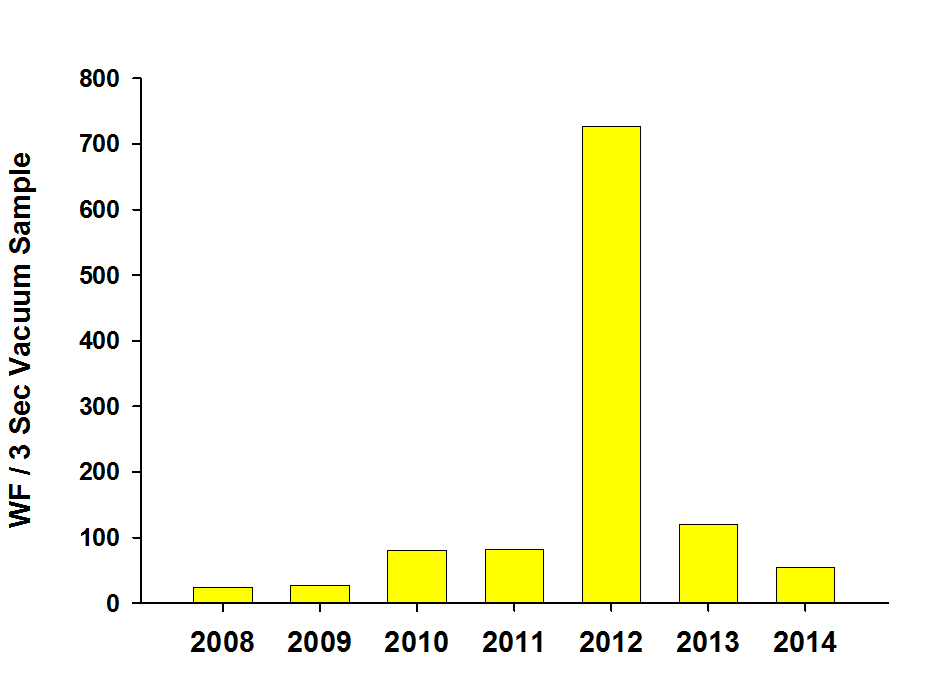
|
|
|
|

|
|||
|
|
|||
|
Now that produce planting/transplanting is well underway, one of the first pests
you’re likely to encounter is adult whiteflies. Given the high numbers found on
spring melons and cotton this summer, one would also expect whiteflies to be heavy
on fall produce crops. Surprisingly though, adult numbers have been lighter than
expected on fall melons. For instance here at the Yuma Ag Center, whitefly populations
in our experimental plots based on vacuum samples taken this week are lower than
what we’ve encountered the past few years (see graph below). However, this appears
to be site-specific as I’ve observed melon fields in the Wellton/Roll area with
very high numbers this past week. This makes sense; whitefly population abundance
can be influenced to a large extent by the crop landscape throughout Yuma. Crops
planted near or adjacent to cotton and alfalfa are clearly more heavily infested
than fields isolated away from these crops. In addition, our monsoon conditions
often play a role where humidity and rainfall can influence population abundance.
Nonetheless, you can bet heavy whitefly numbers will eventually show up in one of
your fields. It is important that PCAs pay particular attention to early whitefly
control on their newly planted produce crops. Prolonged feeding by heavy numbers
of adults on seedling lettuce/cole crop plants can cause stunted plant growth. If
you observe honeydew on leaves in the absence of nymphs then there are way too many
adults on the seedling plants. There are likely too many eggs being laid as well.
With the loss of endosulfan, growers have few options for effective residual control
of adults, but good knockdown can be achieved on lettuce and cole crops with combinations
of pyrethroids tank-mixed with Orthene, Lannate, Lorsban, Venom, Scorpion, or Sequoia.
In addition, Exirel (the foliar formulations of Cyazypyr) was recently labeled for
use on produce crops and can provide excellent adult control. Sometimes it can be
difficult to determine whether a product is working 3-4 days following application
when adult whiteflies are continuously moving into you field from outside sources.
To assess adult control under heavy migrations, try monitoring young leaves for
the presence of light-colored eggs (newly laid) using a hand lens. Absence of newly
laid eggs can be an indication that adults are not actively feeding on leaves or
are dying before they can lay eggs. Furthermore, allowing adults to remain unchecked
on small plants generally results in the development of large nymph populations
that can cause significant growth/yield reductions in all produce crops. It is strongly
recommended that growers apply a soil insecticide on lettuce and cole crops throughout
September and early October. Local research has shown that imidacloprid applied
at 0.25 lbs AI/ac at planting provides less residual control of nymphs today than
it did 10 years ago. However, given the current economics of imidacloprid, cost-effective
whitefly control can still be achieved by using higher rates of imidacloprid (0.38
lbs. AI/ac) to extend residual control (e.g., Alias 2F-24 oz; Wrangler 4F-12 oz;
Admire Pro- 10.5 oz). Verimark, the soil formulation of Cyazypyr, applied at 13.5
oz/ac can provide excellent control of nymphs when applied at planting similar to
the neonicotinoids to lettuce and cole crops. Once plants get larger, products like
Movento, Exirel, Venom, Scorpion, Assail, Knack and Courier/Vetica can provide effective
control of nymphs. For more information on whitefly biology, management and insecticide
alternatives see these reports:
Whitefly Management in Fall Produce- 2014 and
Insect Management on Desert Vegetables and Melons: Whitefly.

Remember, When in Doubt . . . . . “Call Barry Tickes”
Click picture to listen to John’s update
To contact John Palumbo go to: jpalumbo@ag.arizona.edu |
|||
| Back | |||
|
For questions or comments on any of the topics please contact Marco Pena at the Yuma Agricultural Center.
|
|||
|
Home |
Cotton | Veggies |
Forages | Grains
| Citrus |
Crop x Crop Insects | Diseases| Weeds | Pesticides | Economics | News | Weather | Research | Photos | Contacts | General Info. Copyright © 2001 University of Arizona, College of Agriculture and Life Sciences Webmaster: Al Fournier (acis@ag.arizona.edu) |
|||
